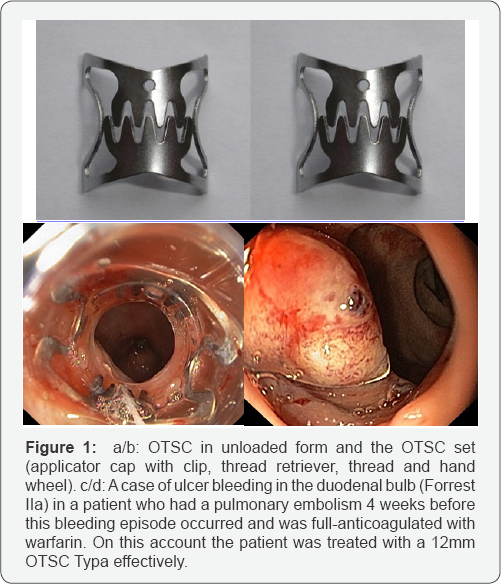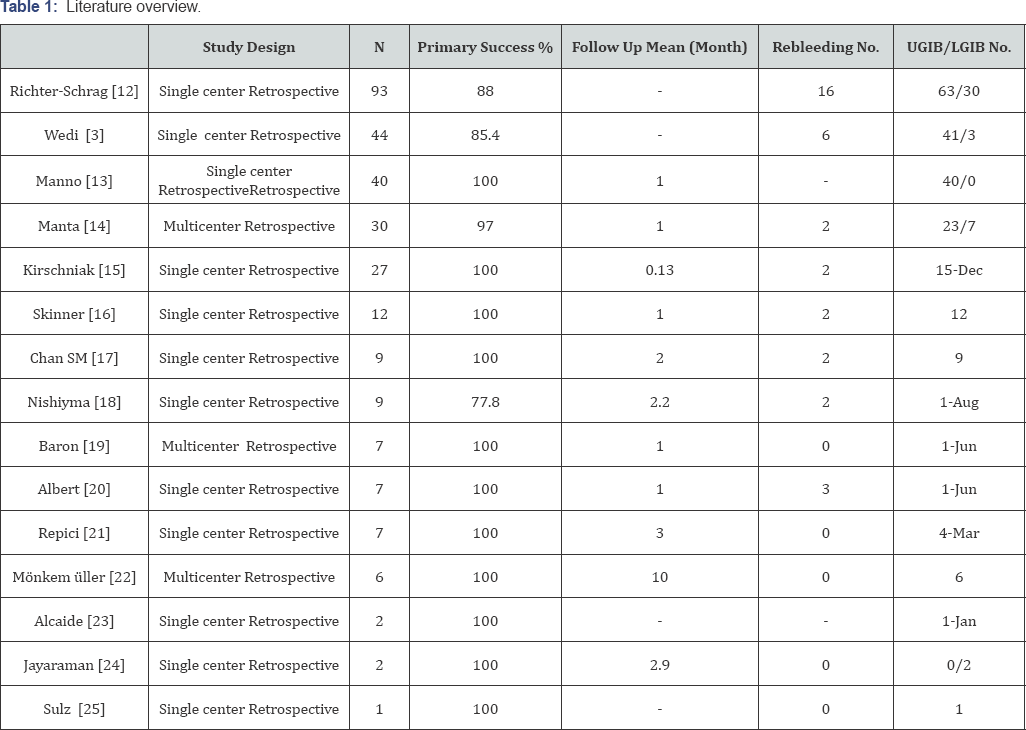A Novel Over-The-Scope Clip (OTSC) For the Treatment of Severe Non-Variceal Upper GI-Bleeding: An Alternative to Classic Hemostatic Techniques?_Juniper Publishers
ADVANCED RESEARCH IN GASTROENTEROLOGY & HEPATOLOGY JUNIPER PUBLISHERS
Authored by Wedi E
Abstract
Gastrointestinal bleeding is a frequent endoscopic emergency. The mortality rate, due to non-variceal upper gastrointestinal bleeding (NVUGB), remains despite technical advances between 5-10%. Conventional endoscopic treatment includes through the scope clips (TTSC), injection therapy and thermal therapy. The over-the-scope-clip (OTSC) is a novel endoscopic device, that overcomes limitations of standard clips and achieves a more efficient and reliable haemostasis in non-variceal upper gastrointestinal bleeding (NVUGIB). His review article gives an overview of the recently published data on this topic and discusses future perspectives in GI-bleeding management.
Keywords: Endoscopy; Non-variceal upper gi bleeding; Over-the-scope clip; OTSC
Introduction
Gastrointestinal bleeding is frequent in clinical practice and one of the main indications for emergency endoscopy. The mortality rate due to non-variceal upper gastrointestinal bleeding (NVUGB) lies between 5-10% [1]. Conventional endoscopic treatment for NVUGB includes through the scope clips (TTSC), injection therapy and thermal therapy. It has been shown, that a combination of two endoscopic techniques is superior to an individual technique alone and is therefore recommended [2]. Nevertheless, these hemostatic methods have their limitations and can fail in complex bleeding situations, such as fibrotic ulcer ground, vessel diameter >2mm and ulcer localization difficult to access. The over-the-scope-clip (OTSC; Ovesco Endoscopy AG, Tuebingen, Germany) is a new promising endoscopic device, which could overcome these limitations. It consists of super-elastic Nitinol and has the shape of a bear trap mounted on a transparent cap (Figure 1a) [3]. The mechanism of action is comparable to the application mechanism of variceal- band ligation devices. After clip application the tissue is kept vital based on a pre-defined distance between the clip teeth promoting sufficient vascular perfusion [3]. Pre-clinical experiments were performed in porcine models for NOTES procedures (natural orifice translumenal endoscopic surgery), defect closure for targeted perforations and endoscopic full-thickness resection [4-12]. For the treatment of NVUGB, only limited data has been published so far. Therefore the objective of this review is to give a brief insight of recently published studies on this topic, which we have found through a systematic search of the medical database Pubmed.
Results and Discussion
A total of 15 clinical research articleswere identified. The examined clinical studies comprised case series and clinical singlearm studies (Table 1). Krischniak et al. [8] reported in 2007 as one of the first authors in a retrospective clinical trial on eleven patients, the application of OTSC as first-line therapy with a clinical success rate of 100%. No complications were reported after a follow-up of four weeks. In the past, there has been significant improvement in the endoscopic treatment of NVUGIB due to better clipping systems and new substances for topical hemostasis, like the hemospray. Despite these advances, the risk of re-bleeding still remains high, around 20%. The mortality rate in this patient group lies between 10-36% [9-11]. The OTSC can overcome the limitations of standard TTS clips and achieve a more efficient haemostasis. This literature review confirms that by using OTSC in high-risk patients primary hemostasis can be achieved in 77.8-100% (Table 1). Recently published data show higher therapeutic success rates using the OTSC as first-line therapy for gastrointestinal bleeding and for prevention of re-bleeding in high-risk patients [12]. Manno et al. [13] published their experience in 40 cases, where they used the OTSC as first-line therapy in NVUGIB with a technical success and hemostasis in 100% of the treated patients. Another Italien Study reported about 30 patients who were treated with bleeding lesions with primary hemostasis in 97% [14]. To date Richter-Schrag et al. [12] has published the largest patient cohort (n=93) with upper and lower GI bleeding and they could show for the first time that first- line treatment with the OTSC might be the best predictor preventing rebleeding compared to second-line therapy with OTSC after failure of another technique. They concluded that the type of treatment determines the success of primary hemostasis or primary failure. Our own clinical experience show, that after efficient application of the OTSC with successful hemostasis in patients on anticoagulation or antiplatelet therapy, this can be resumed within 24-48 hours after OTSC application. This is a significant advantage of this system. Nevertheless, these patients will remain a challenge in managing bleeding versus risk of stopping anticoagulation. Up to now the published data are promising, but retrospective nature. Prospective randomized trials of emergency situations are difficult to conduct and therefore data is limited in this field [14-26].


Conclusion
In conclusion, this short literature review demonstrates that OTSC application is a successful treatment in patients with complex lesions for the treatment of severe NVUGIB. Prospective studies are necessary to demonstrate the superiority of OTSC in comparison to classic hemostatic techniques.
For More open access Journals in Juniper Publishers Please click on: https://juniperpublishers.com/
For more articles in Advanced Research in Gastroenterology & Hepatology please click on https://juniperpublishers.com/argh/index.php
For more about Juniper Publishers please click on: https://juniperpublishers.com/video-articles.php




Comments
Post a Comment